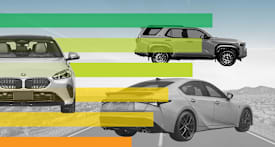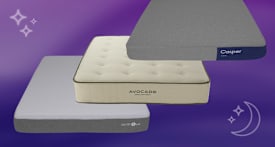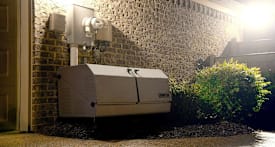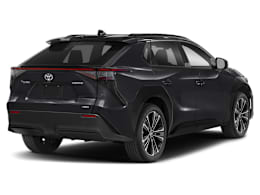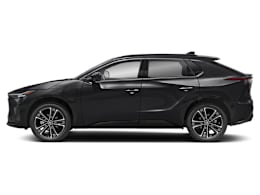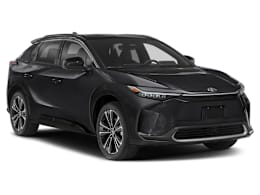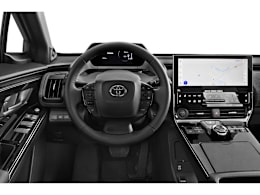The bZ4X is Toyota’s first built-from-the-ground-up electric vehicle. Designed to a popular size, it’s a few inches longer than Toyota’s RAV4 and a couple of inches shorter than the Venza. And what of the “bZ4X” name? Toyota says the small SUV falls under its “beyond zero” brand umbrella, a name that’s a reference to zero emissions. There are six other bZ models to be introduced by 2025. Of note: The bZ4X is nearly identical to the Subaru Solterra, with the biggest difference that the bZ4X comes standard with front-wheel drive, with all-wheel drive optional, while the Solterra comes only with all-wheel drive.
We enjoy the bZ4X’s smooth and quick acceleration, agile and responsive handling, and roomy cabin. And overall, it drives quite decently. But its short electric driving range, slow charging times, and limited EV-specific features make it less appealing than competitors such as the Hyundai Ioniq 5 and Kia EV6. In fact, it feels like a rather half-hearted first attempt at an EV. The key draw for the bZ4X may be Toyota’s well-established reputation for reliability. As shoppers consider making a move to an EV, the promise of solid brand reliability may factor heavily for some buyers.
The front-wheel-drive bZ4X has a 201-horsepower electric motor, while the all-wheel-drive version we tested gets 214 hp from its front and rear electric motors. As with most EVs, the bZ4X scoots off the line with instant, smooth, and nearly silent acceleration, and the all-wheel drive delivers excellent traction to all four tires, even when road conditions are wet and slippery. It feels zippy when driving normally around town, but it runs out of steam quicker than many EVs as speeds increase. In terms of pure acceleration, the bZ4X doesn’t produce the outright forward thrust of most EV competitors, borne out by its 6.4-second run from 0 to 60 mph. While that’s reasonably brisk compared with most vehicles, it’s significantly slower than its direct EV peers, including the Ioniq 5 and EV6, as well as the Ford Mustang Mach-E and Volkswagen ID.4.
Its driving range is also less than the competition. The front-wheel-drive model has an EPA-estimated 252-mile range, while the all-wheel-drive version is rated at 222 miles. Charging speeds are unimpressive as well; while most new EVs come with onboard chargers that range from 7.7 to 11.5 kilowatts, the bZ4X has just a humble 6.6-kW onboard charger, which limits the speed of charging when plugged into a typical Level 2 home charger. It’s also behind the times when it comes to DC fast charging in public places, for example when you’re on a long trip: It’s only capable of a maximum acceptance rate of 100 kW, while most EVs these days can take between 170 to 250 kW.
Also unlike most EVs, the bZ4X only briefly displays its current predicted driving range and battery state-of-charge within the instrument panel when the driver’s door is opened while charging. It also lacks an LED indicator showing the current charge level inside the charge-port, and it doesn’t tell you the speed you’re charging at.
On a more positive note, the bZ4X’s handling is agile and secure, helped by the car’s relatively low center of gravity due to the battery pack mounted underneath the floor. The steering is quite responsive, with a nice weight that increases naturally as you turn the wheel. This makes it a fairly nimble SUV that’s inviting to push on curvy roads or through sharp highway exit ramps. The ride is mostly absorbent, but it’s marred by short, frequent body motions that make the bZ4X feel jittery even on fairly smooth pavement. Our tested Limited’s 20-inch tires (the base XLE trim comes with 18s) are likely partly to blame for this. While the bZ4X is a quieter vehicle than most on the road, the cabin isn’t as hushed as EV competitors such as the EV6, ID.4, or Ioniq 5.
Panic-brake stopping distances are competitively short, and we appreciate that the bZ4X’s brake pedal doesn’t suffer from an annoying grabbiness during low-speed driving like we’ve experienced in many EVs. The pedal does exhibit a slightly spongy sensation with a longer travel when slowing down from higher speeds. Although Toyota lets drivers alter the car’s regenerative-braking levels by tapping paddles behind the steering wheel, the deceleration levels are relatively mild compared to most other EVs—if you like “one-pedal driving,” which gives the ability to come to a stop without having to step on the physical brake pedal, you’re going to be let down. Of note, the bZ4X has a button on the center console with a foot-and-pedal symbol that engages maximum brake-regen, but even this setting isn’t strong enough to bring the car to a stop.
The austere interior doesn’t seem fitting for a $50,000 car. There are lots of hard, unpadded surfaces, and some of the trim pieces feel cheap and hollow. Inexplicably, the bZ4X doesn’t have a glove box. It also doesn’t have a rear window wiper, an annoying trend we’ve noticed on other SUV-like EV models. The driving position is relatively spacious, with excellent headroom and a “floating” center console that gives plenty of room for the driver’s right knee. But the location of the driver’s instrument panel, which is placed far forward and nearly at the base of the windshield, is just plain weird and can be difficult to get used to. Since you look over the top of the steering wheel (rather than through it) to see the instrument panel, it requires tilting the steering wheel down to a lower position than feels normal in order for the steering-wheel rim to not cut off any of the readouts that are on the bottom portion of the panel, such as the small predicted driving range display.
Most of our drivers found the front seat decent in terms of comfort. The side bolsters form a nice pocket to sit in between, and the cushions are reasonably plush. But, support starts to wane after about 45 minutes in the saddle. The rear seat is unimpressive: There’s plenty of knee room, but headroom is bound to be tight for taller adults, and the seat is situated so low to the floor that there’s barely any under-leg support.
The bZ4X’s controls and infotainment system have a few tedious aspects. For example, many climate controls are handled with touch-capacitive “buttons” on a panel, aside from a few physical toggle switches, and unfortunately the panel isn’t always responsive to inputs. The infotainment touchscreen also brings some annoyances, but at least the steering-wheel controls are easy to use. The large gear-selector knob takes some time to master; you have to press down on it first before you twist it left or right to shift into Reverse or Drive, respectively, which is unintuitive.
The bZ4X comes with the “Toyota Safety Sense 3.0” (or TSS 3.0) suite of active safety and driver assistance features. Standard systems include automatic emergency braking with pedestrian, cyclist, and motorcyclist detection; as well as automatic emergency braking that operates at highway speeds, blind spot warning, rear cross traffic warning, reverse automatic emergency braking, lane centering assistance, lane departure warning, lane keeping assistance, adaptive cruise control, and automatic high beams. It also comes standard with a rear occupant alert system that’s designed to help prevent kids and pets from dying when unintentionally left behind in hot vehicles.

